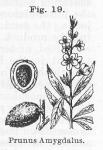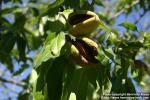
 Preparations: Bitter Almond Water - Emulsion of Almond - Syrup of Almond - Compound Powder of Almond - Spirit of Bitter Almond
Preparations: Bitter Almond Water - Emulsion of Almond - Syrup of Almond - Compound Powder of Almond - Spirit of Bitter Almond
Related entries: Oleum Amygdalae Expressum (U. S. P.)—Expressed Oil of Almond - Oleum Amygdalae Amarae (U. S. P.)—Oil of Bitter Almond - Prunus (U. S. P.)—Prune- Amygdalus Persica.—Peach Tree- Laurocerasi Folia.—Cherry-Laurel Leaves - Prunus Virginiana (U. S. P.)—Wild Cherry- Acidum Hydrocyanicum Dilutum (U. S. P.)—Diluted Hydrocyanic Acid
I. AMYGDALA AMARA (U. S. P.)—Bitter almond. "The seed of Prunus Amygdalus, var. Amara, De Candolle" (U. S. P.). (Amygdalus communis, var. Amara).
II. AMYGDALA DULCIS (U. S. P.)—Sweet almond. "The seed of Prunus Amygdalus, var. Dulcis, De Candolle" (U. S. P.). (Amygdalus communis, var. Dulcis).
ILLUSTRATION: Bentley and Trimen, Med. Plants, 99.
Botanical Source.—The Prunus Amygdalus, or Almond tree, is from 10 to 18 feet high, with a pale-brown, rugged bark, and dividing into many spreading branches. The leaves, which are borne on glandular petioles, are between 2 and 4 inches long, about 9 lines broad, lanceolate, acuminate, thin, serrated, bright light-green, and glandular near the base. The flowers are moderately large, pink or white, sessile, and in pairs, appearing before the leaves. The calyx is reddish, with blunt segments. The petals are variable in size, always much larger than the calyx, ovate, concave, and irregularly notched. Stamens spreading, about half the length of the petals. The ovary is wooly; the style simple. The fruit a leathery, hoary drupe, with the sarcocarp spontaneously cracking and dropping off the putamen. The stone is oblong, or ovate, acute, hard in various degrees, always rugged, and pitted with irregular holes. The seed is oblong, compressed ovate, with brown testa, at the apex of which there is a broad, round, brown chalaza. The cotyledons are very large, and plano-convex. Both the sweet and bitter almonds are taken from this tree, of which there are several varieties—the sweet almond is obtained from the var. Dulcis, and the bitter almond from the var. Amara (L).
History.—The Almond tree is indigenous to most of the southern parts of Asia and Barbary, and is cultivated in many parts of Southern Europe. According to Consul Mathews, of Tangier, the almond tree "is remarkable for the facility in raising it, for its hardiness in standing continued droughts, growing in the poorest soils, in the sands, gravels, and amongst rocks; and finally for the abundance of, and high price which its fruit commands. * * * At the sixth year the almond trees commence to yield by far greater product than the expenses incurred in their raising and cultivation, owing to their rustic habit, requiring no care from the time of their planting to the long period which these trees live" (U. S. Special Consular Reports, Vol. XL, 1889-90).
The varieties of sweet almond found in commerce are the Valencia, Italian, Barbary, and Jordan. The latter, which are the finest of the sweet almonds, come from Malaga. They are hard-shelled, though they are generally deprived of the shell before being put on the market. The Barbary variety is the smallest and cheapest. The soft-shell (paper shell) variety from Majorca of the Balearic Isles, is shipped from Valencia, and French and Italian ports on the Mediterranean coast. They are derived from Prunus Amygdalus, var. fragilis, De Candolle. The Jordan, or Malaga almonds, differ from all others in being much longer and of larger size. The bitter almonds are imported principally from Mogador, in Morocco. So far as the external appearance goes, they can not be differentiated from the sweet almonds, except the long Jordan variety. Almonds are now cultivated to some extent in California. The bitter variety is said to grow wild in Greece. The almond has been known from the earliest times, having been one of the presents carried down into Egypt by Jacob's sons (Gen., ch. xliii, v. 11). Among the bitter almonds the following are the chief varieties: the French, the best product; the Sicilian; and the Barbary, or least valuable kernel.
Description.—I. AMYGDALA AMARA (U. S. P.), Bitter almond. "About 25 Mm. (about 1 inch) long, oblong-lanceolate, flattish, covered with a cinnamon-brown, scurfy testa, marked by about 16 lines emanating from a broad scar at the blunt end. The embryo has the shape of the seed, is white, oily, consists of 2 plano-convex cotyledons, and a short radicle at the pointed end, and has a bitter taste. When triturated with water, bitter almond yields a milk-white emulsion, which emits an odor of hydrocyanic acid"—(U. S. P.).
II. AMYGDALA DULCIS (U. S. P.)—Sweet almond. "Closely resembling the bitter almond (see Amygdala Amara), but having a bland, sweetish taste, free from rancidity. When triturated with water, it yields a milk-white emulsion, free from the odor of hydrocyanic acid"—(U. S. P.).
Chemical Composition.—Both varieties of almond contain oil; the sweet, a fixed oil (see Oleum Amygdalae Expressum), the bitter, a fixed oil (see Oleum Amygdalae Expressum), and a glucoside, called amygdalin, capable of splitting into hydrocyanic acid, dextrose, and benzaldehyde (see Oleum Amygdalae Amarae). The fixed oil may be obtained by expression; it is colorless, or slightly yellowish, sweet and bland to the taste. The essential oil, called oil of bitter almonds, consisting of benzaldehyde (C6H5CHO), and hydrocyanic acid, may be obtained from the bitter almonds by first depriving them of their fixed oil by expression, subjecting the residue to the action of cold water for some hours, and finally distilling the product. The reaction involved is as follows: Amygdalin (C20H27NO11) is converted, under the influence of emulsin (synaptase), a vegetable protein ferment present in the bitter and sweet almond, into dextrose, hydrocyanic acid, and benzaldehyde (oil of bitter almonds), as follows: C20H27NO11+2H2O=CNH+2C6H12O6+C7H6O (Wöhler and Liebig). Emulsin is non-poisonous, and is obtained in an amorphous state. Its activity upon amygdalin is destroyed by boiling heat. Another proteid body, which is likewise soluble in water, is present in the almonds. It was named conglutin, by Ritthausen, while Comaille denominated it amandin. It is to this body, and emulsin, that the emulsification of oil of almond in water is due. Amygdalin exists only in the bitter almond. On boiling amygdalin in alkaline solution, it splits up into amygdalic acid (C20H28O13), and ammonia. With diluted acids, amygdalic acid yields mandelic (phenylglycolic) acid (C8H8O3) and grape sugar. In 1895, E. Fischer succeeded in eliminating from the molecule of amygdalin one molecule of dextrose by acting upon it with an aqueous extract of beer yeast. He thus obtained a new glucoside (C14H19NO7), which closely resembles amygdalin, and splits under the influence of emulsin into the same products; it differs from amygdalin in melting point and solubilities. The integuments of almonds contain both cane and grape sugar, the latter predominating, a green, resinous body, and a bitter, yellow principle having an acrid taste (thought to be a glucoside). Tannin has been found in the unblanched kernels. The almonds contain mucilage and protein matter, and yield in the ash, phosphates of calcium, potassium, and magnesium. Amygdalin is obtained also from many barks, flowers, seeds, and leaves of plants of the natural order Rosaceae, those of the sub-orders Amygdaleae and Pomeae seeming to yield it in considerable amounts.
Amygdalin (C20H27NO11), is obtained by freeing bitter almonds from their fixed oil by pressure and extracting the residue with boiling alcohol, evaporating the solvent and recrystallizing the residue. It is a crystalline body, has a sweetish bitter taste, is soluble in cold water (1 in 12), slightly soluble in cold, but easily soluble in hot alcohol, insoluble in ether. It is said to be poisonous, even in the absence of emulsin (Moriggia and Ossi). Its solution is laevo-rotatory. When crystallized, it contains three molecules of H2O, which is expelled when amygdalin is heated to 120° C. (248° F).
Seventeen grains of amygdalin dissolved in 1 ounce of emulsion of sweet almonds, furnishes 1 grain of pure hydrocyanic acid, an amount of acid equivalent to 50 minims of the official diluted hydrocyanic acid. The oil of bitter almonds is a poison acting in the same manner as hydrocyanic acid, unless the acid be removed from it by shaking with milk of lime and ferrous sulphate (Liebig and Wöhler). One drachm of it dissolved in 3 fluid drachms of alcohol, forms an "essence of almonds," much used by confectioners, perfumers, etc. The oil of bitter almonds has a golden-yellow color, an agreeable, prussic acid-like odor, and an acrid, bitter taste. It is combustible, burning with a white flame, its specific gravity varying from 1.060 to 1.070; soluble in alcohol or ether, and in water (300 parts); communicates its odor and taste to water, and yields foliaceous crystals of benzoic acid upon standing for a time exposed to the atmosphere.
Action, Medical Uses, and Dosage.—SWEET ALMONDS. Triturated with water, sweet almonds produce a white mixture called emulsion or milk of almonds, which possesses a very remarkable analogy with animal milk; it contains a. great quantity of oil, kept in suspension in water by the presence of sugar, gum, and albumen, and is used as a demulcent and as a vehicle for other medicines. The oil, in small quantity, acts as a demulcent; in larger doses it is laxative. It is frequently employed in cough, diseases attended with intestinal irritation, and for mitigating the acrimony of the urine in calculous affections, cystitis, gonorrhoea, etc. Externally the oil is sometimes used in lotions and cosmetics. The kernels have been made into a bread, as well as cakes and pudding, to take the place of wheaten bread in diabetes. Dose of the oil, 1 to 2 fluid drachms.
BITTER ALMONDS.—Bitter almonds are sedative, and in large doses poisonous. The toxic symptoms and treatment are those of hydrocyanic acid (which see). The oil of bitter almonds, or bitter almond water, is commonly employed, and may be used as a substitute for hydrocyanic acid. Dose of the oil, 1/4 of a drop to 1 drop, in emulsion, and cautiously increased. Seldom used.

